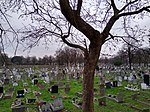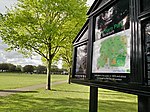Plaistow tube station
1858 in LondonDistrict line stationsFormer London, Tilbury and Southend Railway stationsHammersmith & City line stationsPlaistow, Newham ... and 5 more
Rail transport stations in London fare zone 3Railway depots in LondonRailway stations in Great Britain opened in 1858Tube stations in the London Borough of NewhamUse British English from August 2012

Plaistow ( PLAHST-oh or PLAST-oh) is a London Underground station on Plaistow Road in the London Borough of Newham in Greater London. It is between West Ham and Upton Park stations on the District and Hammersmith & City lines, and in Travelcard Zone 3.
Excerpt from the Wikipedia article Plaistow tube station (License: CC BY-SA 3.0, Authors, Images).Plaistow tube station
Queen's Road West, London Plaistow (London Borough of Newham)
Geographical coordinates (GPS) Address Nearby Places Show on map
Geographical coordinates (GPS)
| Latitude | Longitude |
|---|---|
| N 51.53138 ° | E 0.01722 ° |
Address
Queen's Road West 4
E13 0PF London, Plaistow (London Borough of Newham)
England, United Kingdom
Open on Google Maps






